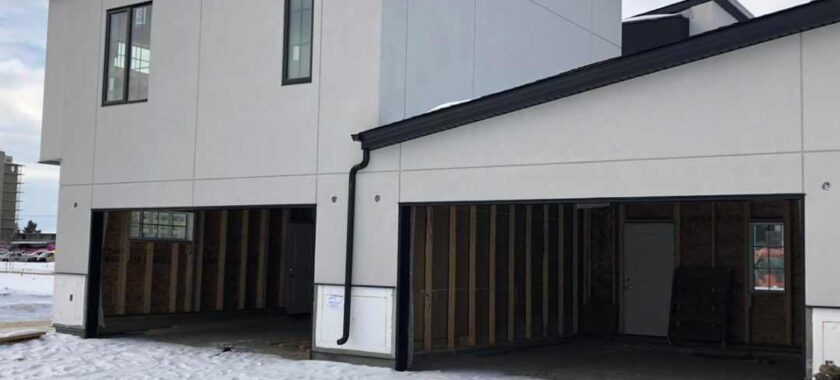For homeowners, winter can be particularly difficult when it comes to keeping garage doors operating properly. More than just a hassle, a frozen garage door can result in expensive repairs, component damage, and decreased energy efficiency. Thankfully, there are practical ways to keep your garage door from freezing. At Iceberg Overhead Doors, we provide expert garage door weather seal services in Edmonton to protect your garage from the freezing winters. So you don’t have to worry about a frozen garage door this winter.
What Causes a Garage Door to Freeze?
Knowing why freezing occurs can help prevent it. The buildup of moisture from snow, ice, or rain seeping beneath the garage door can cause it to freeze shut. This moisture freezes when the temperature drops, making the door adhere to the floor. Water seeping beneath the door due to poor weather seals might worsen this problem. Moisture from cold air flowing inside the garage can freeze around seals and moving parts. Furthermore, poor maintenance on tracks, hinges, and rollers can make freezing problems even worse.
Have a good Weather Seal
The first line of defense against freezing is a strong weather seal. These seals keep water from getting inside and freezing by forming a barrier between the garage door and the ground. Purchasing a garage door weather seal is extremely recommended and is crucial for Edmonton homeowners. High-quality seals are composed of vinyl or heavy-duty rubber, which guarantees flexibility and endurance in cold conditions. To guarantee a tight fit, they should also be made for the particular door model you have. Regularly inspect your weather seal for wear or cracks, and replace it immediately. To ensure a precise fit, remove the old seal, wipe the garage door’s bottom to remove any debris, slip the new seal in place or use glue to secure it, and trim any extra material.
Keep the Space Near the Door Clear
Freezing may result from snow and ice accumulation close to the garage door. To avoid this, regularly remove snow from the driveway and the areas around the garage door. The ice around the door can be melted using de-icing salt, but too much salt can harm concrete, so use it sparingly. By establishing adequate drainage around the garage, you can lower the chance of freezing by preventing water from collecting close to the entrance.
Lubricate moving Garage Components
Lubricants may thicken or dry out in cold conditions, which could interfere with operation. Tracks, hinges, rollers, and springs should all be lubricated with silicone-based lubricants suitable for winter conditions. Grease can thicken in the cold and make the issue worse, so stay away from it.
Spray the Bottom Seal with Silicone
The bottom seal can be kept from freezing to the ground by using a silicone spray. Clean the bottom seal to remove any dirt or debris, then apply a thin, even layer of silicone on it. Allow it to cure completely before shutting the door. To keep the spray working throughout the winter, reapply it as necessary.
Make Your Garage Door Insulated
Keep your garage door insulated. You can lessen the chance of freezing by keeping the interior temperature steady. Spray foam, foam boards, and reflective insulation are common choices for garage door insulation. Insulation lowers energy expenses, makes the garage warmer, and stops moisture that could cause freezing.
Put in a Garage Heater
A long-term fix for freezing prevention is a garage heater. To prevent water from turning to ice, the temperature should be kept above freezing. Infrared heaters are effective and silent, propane heaters are portable and strong, and electric heaters are simple to install and use.
Apply a De-Icing Agent
A de-icing solution may help prevent your garage door from freezing shut. To make your own homemade de-icing agent, combine a cup of water, two cups of rubbing alcohol, and a few drops of dish soap. After applying this solution to the bottom seal, carefully open the door.
Prevent Condensation and Drafts
Drafts of cold air can generate condensation, which might then freeze and cause issues. Use caulk or foam insulation to fill any gaps around the door frame to stop airflow. Another line of defense against water and drafts is the installation of threshold seals. Maintaining adequate ventilation in the garage also keeps condensation from developing, which keeps your garage door operating.
Carry Out Maintenance
Even in the cold, your garage door will function smoothly with regular maintenance. Examine and adjust the hardware, verify the door’s balance, test the auto-reverse safety mechanism, and clean the tracks to eliminate debris. Maintaining peak performance and avoiding freezing problems can be achieved by scheduling an annual professional tune-up.
Use Care When Opening Your Garage Door
Avoid forcing your garage door open if it feels stuck, as this could harm the door or its parts. Instead, check for ice accumulation, melt the ice with warm water or a de-icing solution, and then carefully raise the door once it is free.
It takes both proactive steps and routine maintenance to keep your garage door from freezing shut. A few actions that can have a big impact include keeping the area free of snow and ice, installing a high-quality garage door weather seal, and keeping the area well lubricated. You can save time, money, and irritation by using these techniques to make sure your garage door runs properly all winter long.
We offer high-quality garage weather seals in Edmonton and 24/7 emergency garage door repairs. With expert installation and durable seals to withstand the harsh Edmonton winters. Whether in a pinch or looking for regular maintenance, trust us with all your garage door problems.









